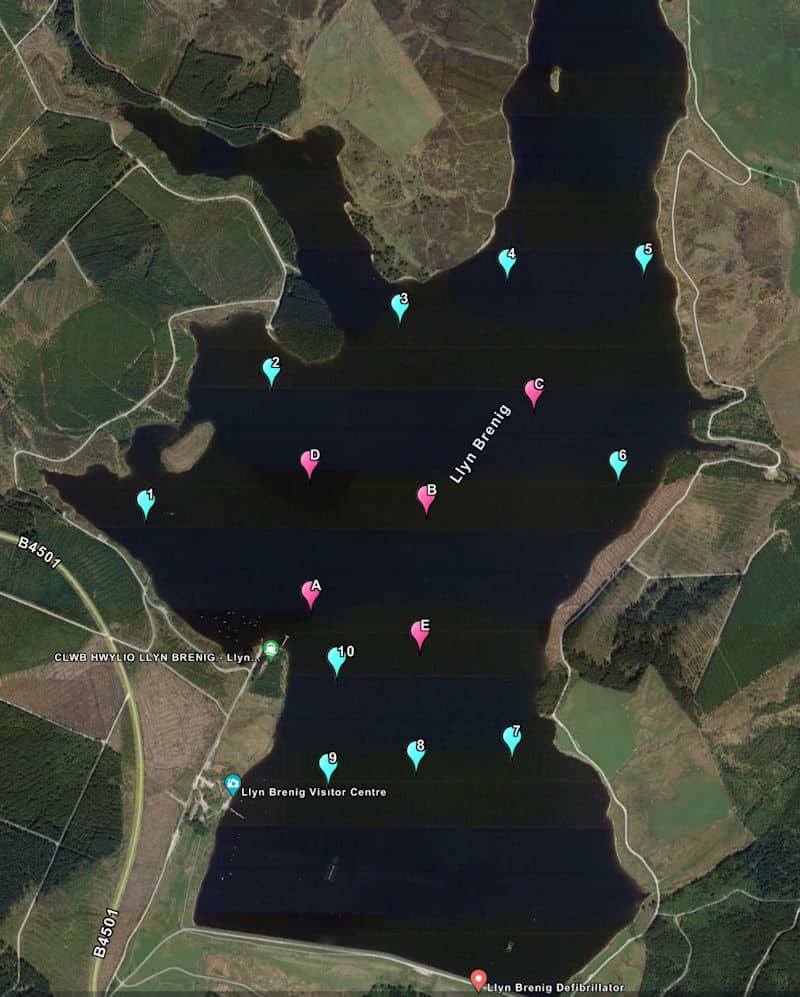The first thing to say about racing at Llyn Brenig is that we are a friendly club and our intention is to have some great fun – and we do. So although we sail to the RYA racing rules, we practice a “lightish touch” to these. No one can remember when we last had a protest committee!
The main rules used are: no barging at the start; windward boat to keep clear; water at the mark must be given when appropriate; port starboard rules prevail; and anyone colliding with either a buoy or a boat must do their turns!
Club racing is the main racing activity, but open meetings and open regattas are regular features of the sailing programme, as are training events. The sailing programme details how the racing season is managed with different series, regattas and other events.
Club racing takes place on Sundays and the season runs from March to November, though there are few takers for the early and later months!
The map of the lake shows the approximate location of the buoys.

Racing takes the form of Handicap or Pursuit racing using the Portsmouth Yardstick scheme, which issues all classes of boat with a handicap number: high numbers for the slower boats and low numbers for the faster ones. This allows all types of racing dinghies to compete equally using a calculator to divide each boat’s finishing or elapsed time by its handicap number.
From April to October there are three races a day, one before lunch and two after. The first race starts at 11.30 and the later ones at the discretion of the Race Officer, usually around 13.30 and 14.30.
Race 1 is a Handicap race where the results are calculated at the end of the race as described above. Race 2 is a Pursuit race, where the slower boats start first and the faster ones later.
In the Pursuit race the start times of each class of boat is determined using the Portsmouth Yardstick. The slowest boat might have an advantage of many minutes over the faster ones and it’s up to the fast boats to catch the slower ones. This can be very exciting racing indeed with the result not known until the final minutes or, on occasion, seconds.
Summarising the difference between Handicap and Pursuit is that in the former the calculations are done after the race and the latter before the race.
The third race of the day is another Handicap and we try to run the second and third races ‘back to back’. This means that there is no return to shore between these two races and allows people more chance to have their boats parked up and crews changed out of sailing clothing at a reasonable time.

Racing is controlled by the use of flags and sound signals, there are as many flags as there are letters in the alphabet plus the numbers 1 to 10! Bewildering?
In fact, we manage with half a dozen or so. Often only two are required, which are H and P. These are the race start flags. H is hoisted to begin the 5 minute starting sequence, followed 1 minute later by P the preparatory flag, also called the Blue Peter. After 4 minutes with one minute to go P is lowered, at 5 minutes H is lowered and the race starts.
At every move of each flag, a sound signal is given; we use a car horn arrangement which is connected to a portable battery. The purpose of the sound signal is to draw the attention of the competitors to the flag, It is the flag that delivers the message not the sound signal.
Race duration is usually around 45 to 50 minutes, which might allow for 3 or 4 laps around the buoys that the race officer has chosen for that first race though the course can often be changed for subsequent races depending on the wind direction.
There are 15 buoys around the lake numbered 1 to 10 and lettered A to E. With the number and variety of positions of the buoys, it should always be possible to offer a course that gives fair sailing for everyone.
Ideally, each race should incorporate a beat which sails as close to the wind as possible, a reach when the wind is directed at the side of the boat, and a run when the wind is blowing from behind the boat.
Of course there are many variations on these points of sailing, a reach can be close or broad for example.
While all this activity is taking place there will be at least one Patrol boat, sometimes two if the weather demands it, on station on the water to observe the activity on the water, the helm of the Patrol boat will be in contact with the race officer who can direct the Patrol boat to wherever his presence might be required.
Whilst racing is taking place there might well be other boats that are not racing. Cruisers, Drascombe type open boats and juniors receiving race training and at busy times, there could be 20 to 30 boats out plus fishing boats who we share the water with.
We welcome all sailors who wish to join us and have some fun on the water.